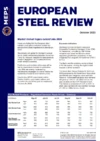6 reasons why European steel prices will rise in September
Steel buyers are returning from their summer holidays and questioning where steel prices are heading next. The answer is…
Upwards.
It has been a very challenging time for all participants in the steel supply chain. The coronavirus pandemic resulted in national governments imposing large-scale lockdowns. Steel producers and distributors faced a slump in orders, as end-user activity was, in many cases, brought to a standstill. Steel prices fell, amid the downturn in demand. But the market could be about to turn a corner.
Here are 6 reasons why MEPS predicts that European steel prices will increase in the short term.
1. Unsustainable margins
Firstly, European mills cannot withstand such extremely weak financial positions for much longer. Steel producers faced deteriorating conditions throughout 2019. The Covid-19 crisis has severely compounded these difficulties. Since the spring of this year, steel prices reduced and raw material costs increased, resulting in unsustainably low profit margins.
The mills need to lift spot market prices before negotiations commence for 2021 annual and half-yearly contracts. Having a significant proportion of their order books locked in at the current low prices would likely cause irreparable damage to a number of steel producers, given their existing precarious financial situation.
2. Rising costs
The cost of steelmaking raw materials has increased dramatically since late March/early April. Iron ore prices have soared by 57 percent to reach a six-and-a-half-year peak at close to US$130 per tonne, amid record high Chinese steel production.
Increases were also substantial for the benchmark Turkish scrap import value – up 38 percent since the start of the second quarter. Scrap availability was disrupted by coronavirus-related lockdown measures. Meanwhile, purchasing by mills in Turkey was generally strong.
Reductions occurred in coking coal prices – down 25 percent in the equivalent time period, as supply outstripped demand. Nevertheless, this has done little to offset the surge in iron ore and ferrous scrap expenditure.
3. Uncompetitive imports
Thirdly, China’s insatiable appetite for raw materials and finished steel is lifting the prospects for a global steel price recovery. The country became a net steel importer in June, for the first time in more than eleven years, amid substantial fiscal spending and monetary easing.
China’s rapid, stimulus-fuelled recovery from the virus pandemic enabled major steel exporters, such as those in Russia and Turkey, to lift hot rolled coil values by around US$100 per tonne following the crash recorded in March/April.
The price revival in Europe is lagging that witnessed overseas. This is resulting in uncompetitive offers from third country suppliers, as they prefer to target more lucrative markets outside the EU.
4. Trade protection
Another factor expected to influence the near-term steel price trend is trade protection measures. The European Commission implemented revised safeguard quotas on July 1, 2020. Consequently, import volumes from major suppliers, such as Turkey, Russia and India, are expected to reduce.
Moreover, antidumping and antisubsidy investigations are ongoing into Turkish-origin hot rolled coil. In addition, further trade action could be imposed by the European authorities, for example, an upward adjustment to Severstal’s €17.60 per tonne import duty.
The threat of paying tariffs and duties, and the added complexities to importing that the trade protection measures create, are expected to dissuade many steel buyers from purchasing material from overseas suppliers in the coming months.
5. Tightening supply
Along with the likelihood of reduced import volumes, domestic supply is tightening. A substantial amount of capacity was taken out of the market in recent months. European crude steel production fell by more than 25 percent, year-on-year, in the second quarter of 2020. As well as the coronavirus-related production cuts, many steelmakers are undertaking plant outages for traditional summer maintenance work.
A lag between demand returning and steel producers ramping up output at their furnaces and rolling mills is expected. This is demonstrated in the current, extending delivery lead times being offered by EU steelmakers.
6. Recovering demand
Finally, signs of a revival in steel consumption are apparent. The IHS Markit Eurozone Manufacturing PMI was 51.8 in July 2020. The last time the monthly index registered an expansion was in January 2019. The growth indicates that a recovery is underway in the manufacturing industry.
During the second quarter of this year, production at European vehicle makers was severely negatively affected by the Covid-19 lockdown measures. As a consequence, steelmakers that rely heavily on the auto sector saw a dramatic drop in their order books. This forced EU mills to find alternative buyers for their steel products, at reduced selling prices.
An upturn in demand from automotive companies bodes well for an improvement in conditions in the steel sector and the prospects for steel price increases.
But downside risks remain
Despite a number of factors supporting an upward trend in European steel prices in the short term, one large downside risk remains.
Covid-19.
A resurgence in contagion rates is being witnessed across Europe. Additional measures to curb the spread of the virus would be expected to constrain the economic recovery.
Furthermore, the full financial implications of the virus and lockdown restrictions are yet to become clear for both businesses and households. Many economic analysts are concerned that company balance sheets and unemployment levels may get worse before they get better.
Consequently, any recovery in the steel sector should be tempered with a degree of caution.

Source:
European Steel Review
The MEPS European Steel Review is an informative, concise and easy-to-use monthly publication, offering unique professional insight into European carbon steel prices.
Go to productRequest a free publication





